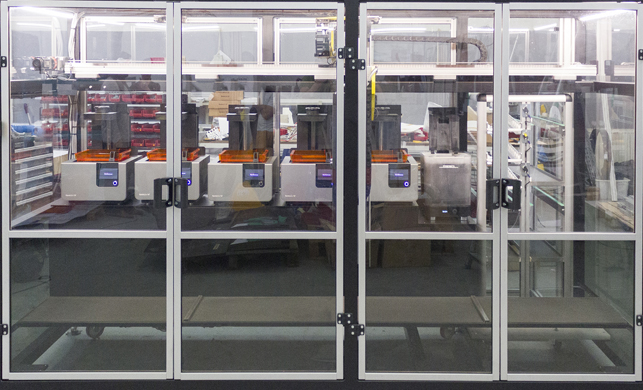Vendors are starting to look into swapping large, costly machines for cheaper ones

Formlabs FormCell — five Form2 machines, a Wash and Cure station and a robotic gantry to automate the whole process
Take a trip around any large-scale 3D printing service provider and you’ll see banks of high-end 3D print hardware.
These are organisations that thrive on volume and throughput. You’ll also typically find that these are longer standing organisations founded when 3D printing was a secret known only to the educated and experienced few.
Just this month Formlabs launched FormCell, a series of its Form 2 SLA machines combined with a fully automated robotic arrangement to move completed builds through its Wash and Cure stations.
Markforged, which is now in both plastics and fi bre as well as metals, has also published its thoughts on the move to lower-cost machines in multiples.
Its CEO Greg Mark commented in a recent blog post that, “Today’s metal 3D printers are the mainframe computers of manufacturing. They are large, slow and expensive ($500k — 1M).
“In the same way mainframes were disrupted by cloud data centres, largeformat metal printers will be replaced by smaller, low cost machines working-inparallel-print-farms.”
Software infrastructure is key
What’s interesting, particularly with the Formlabs and the Markforged announcements, is the importance of the software aspects.
If these machines are to be used in this manner, the success (or indeed failure) of the systems comes down to the software, which ensures these machines are running constantly. Should errors occur, then they need to be identifi ed and resolved quickly.
Markforged’s Mark, comments: “We have spent the last four years building out a comprehensive cloud-based fl eet management solution called Eiger. There are thousands of Markforged printers churning out parts all over the world — all running with full telemetry, error monitoring, feedback, and analytics.”
Meanwhile Formlabs has built “print job scheduling and error detection, remote monitoring, and part and serial number printing” into its own environment.
At the core of these solutions is the combination of low cost, internet connected sensors and some hard-core data analytics.
Just as with traditional manufacturing, there’s a drive to provide a more dynamic, live environment for factory automation and analytics.
Whether referred to as the Chinese Factory 2025, the more European Industry 4.0 or Industry IoT, having a live production system is one thing, but when you’ve got rapid turnaround machines, often building parts that could each be different, customised and adapted to each customer, it’ll be even more key.
Here’s where there’s potential for a startup to come in and disrupt the work already done by the longer term players in the fi eld (whether that’s PTC, Siemens or someone else).
New kid on the block Tulip) is looking to do just this by providing a specific set of tools for industrial automation. In fact, Tulip has linked up with Formlabs for the FormCell and I don’t imagine it’ll be the last.
What of the big costly machines?
The reality is that the large-scale AM machines aren’t going to disappear. After all, large parts will need a large volume machine but what percentage of parts produced can fit inside the volume of a desktop machine? A good proportion I’d bet.
What might start to shift is that this large volume manufacturing can become more accessible for a wider spectrum of potential users. Consider the cost implications of running a third of a million quid’s worth of sintering machine compared to having 10 smaller scale machines at three grand a pop.
If one machine breaks, you can swap it out — probably for less than it’ll cost you to get your honking big machine repaired, and the downtime will be shorter. You’ll have scope to produce in different materials concurrently, or different geometries on different machines.
There will also be potential to rapidly scale up your capability quickly and efficiently. Prior knowledge is immediately applicable — order the new machine, plug it in and away you go.
There’s a lot of potential to the idea — so let’s see where things head, eh?
A new trend is percolating through the additive manufacturing world
Default






